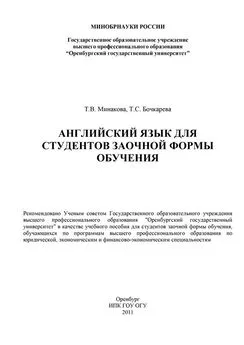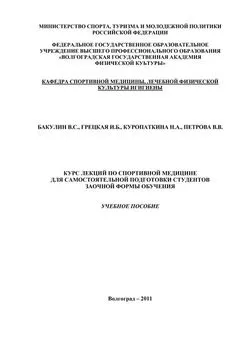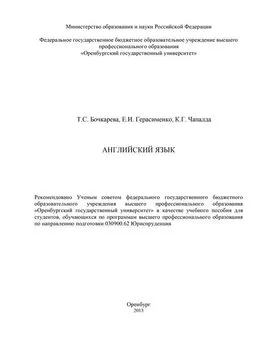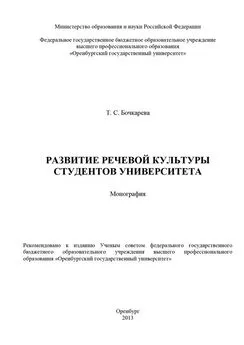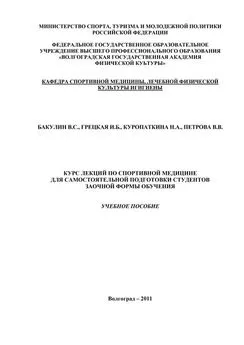Татьяна Бочкарева - Английский язык для студентов заочной формы обучения
- Название:Английский язык для студентов заочной формы обучения
- Автор:
- Жанр:
- Издательство:Литагент БИБКОМ
- Год:2011
- Город:Оренбург
- ISBN:нет данных
- Рейтинг:
- Избранное:Добавить в избранное
-
Отзывы:
-
Ваша оценка:
Татьяна Бочкарева - Английский язык для студентов заочной формы обучения краткое содержание
Английский язык для студентов заочной формы обучения - читать онлайн бесплатно ознакомительный отрывок
Интервал:
Закладка:
financial report – финансовый отчет.
2.2.2.2 Задание 2. Прочитайте тексты А, В, С, переведите их письменно
Тext А. What Is Accounting
As a financial information system, accounting is the process of identifying, measuring, recording, and communicating the economic events of an organization (business or nonbusiness) to interested users of the information. The sale of goods, the rendering of services, the payment of wages are examples of economic events. The first part of the process – identifying – involves selecting those events that are considered evidence of economic activity relevant to a particular organization.
Once identified, the economic events (called transactions by accountants) must be measured in financial terms, that is quantified in dollars and cents.
If the event cannot be quantified in monetary terms, it is not considered part of the company's financial information system. The measurement function thereby eliminates some significant events (such as an appointment of a new company president) because they lack measurability in financial terms.
Once measured in dollars and cents, the events are recorded to provide a permanent history of the financial activities of the organization. Recording consists of keeping a chronological diary of measured events in an orderly and systematic order. In recording, the accountant also classifies and summarizes these events.
Тext В. The Development of Accounting Thought
Accounting has a long history. Some scholars claim that writing arose in order to record accounting information. Account records date back to the ancient civilization of China, Babylonia, Greece, and Egypt. The rulers of these civilization used accounting to keep track of the cost of labor and materials used in building structures like the great pyramids.
Accounting developed further as a result of the information needs of merchants in the city-states of Italy during 1400s. In that commercial climate the monk Luca Pacioli, a mathematician and friend of Leonardo da Vinci, published the first known description of double-entry book – keeping in 1494.
The pace of accounting development increased during the Industrial Revolution as the economies of developed countries began to massproduce goods. Until that time, merchandise had been priced based on managers' hunches about cost, but increased competition required merchants to adopt more sophisticated accounting systems.
In the nineteenth century, the growth of corporations, especially those in the railroad and steel industries, spurred the development of accounting. Corporation owners, the stock holders-were no longer necessarily managers of their business. Managers had to create accounting systems to report to the owners how well their businesses were doing.
The role of government has led to still more accounting developments. When the federal government started the income tax, accounting supplied the concept of "Income". Also, government at all levels has assumed expanded roles in health, education, labor, and economic planning. To ensure that the information that it uses to make decisions is reliable, the government has required strict accountability in business community.
Text C. Communication
This identifying, measuring and recording activity is meaningless unless the information is communicated to interested users. The information is communicated through the preparation and distribution of accounting reports, the most common of which are called financial statements. To make the reported financial information meaningful, accountants describe and report the recorded data in a standartized manner. Such data are said to be reported in the aggregate.
Accountants report financial information on a periodic basis, that is, at regular intervals. The frequency of communicating varies according to the needs of the user and the nature of the information reported. For example, the company's treasurer may request daily reports of cash, the sales manager may require weekly reports of sales, and the president may desire monthly reports of operations as a whole. In contrast, annual statements of financial position and results of operations may be suffice for investors and governmental agencies.
The information is reported to the users of financial reports through ratios, percentages, graphs and charts.
2.2.2.3 Задание 3. Ответьте на вопросы по текстам А, В, С
1 Is accounting part of a financial information system?
2 What parts does the process of accounting consist of?
3 What examples of economic events can you give?
4 Identifying involves selecting of economic events relevant to a particular organization, doesn't it?
5 Can all the events be quantified in monetary terms?
6 What events are not considered part of the company's financial information system?
7 Does the accountant only record the measured events in a systematic manner?
8 What else does he do with the measured economic events?
9 Where do accounting records date back to?
10 Why did the rulers of ancient civilization of China, Babylonia, Greece and Egypt use accounting?
11 What was Luca Pacioli?
12 What spurred the development of accounting in the nineteenth century?
2.2.2.4 Задание 1. Прочитайте и запомните следующие слова и словосочетания:
transactions – сделки;
to carry on – проводить;
to provide – обеспечивать;
mutual savings banks – взаимно- сберегательные банки;
lending – предоставление кредита;
loans – займы;
creditworthiness – кредитоспособность;
acceptance – принятие;
transfer – передача, перевод;
deposits – депозиты;
vaults – хранилища;
to store – хранить;
to insure – страховать;
valuables – ценности;
profitable – выгодный;
interest – процент;
percentage return – доход в виде процента;
account debit cards – карты дебета счета;
electronic cash till – банкомат;
computer on-line banking – компьютерные онлайновые расчеты между банками;
clearinghouses – расчетные палаты;
payments – платежи;
income – доход;
savings – сбережения;
yield – доход;
mortgage – ипотека;
facilities – средства;
handling – обработка;
checking account – 1) специальный счет, с которого снимаются деньги по чекам клиента; 2) счет, позволяющий в любой момент вносить и снимать деньги (до востребования);
rate of interest – процент, процентная ставка, норма процента;
liabilities – задолженность;
assets – актив (баланса);
retail bank – банк, занимающийся обслуживанием мелкой клиентуры;
underwriter – гарант размещения (займа, акций и т.п.);
issue of shares – выпуск акций; intermediary – посредник;
merger – слияние, объединение (коммерческое, промышленное и т.п.);
acquisition – 1) получение; 2) приобретение (действие); сбор;
building society – жилищно-строительное общество;
management buy-outs – выкуп права на управление.
2.2.2.5 Задание 2. Прочитайте тексты А, В, переведите их письменно
Text A. What Is Banking
Banking is the transactions carried onby any person or firm engagedin providingfinancial services to consumers or businesses.
For these purposes there exist commercial banks, central banks, savings banks, trust companies, finance companies and merchant banks. Banking: consists of safeguardingand transfer of funds, lendingor facilitatingloans, guaranteeing creditworthinessand exchange of money. In other words, banking is the acceptance, transfer,and creation of deposits.The depository institutions are central banks, commercial banks, savings and loan associations, building societies, and mutual savings banks.
Safeguarding and transfer of funds
Vaultsand safes are the means for safeguarding of funds. Money is physically storedthere. These physical deposits are in most cases insuredagainst theft,and against the bank being bankrupt and unable to repay the funds. In some banks customers can use safety deposit boxes for valuables.To save money in banks is profitablebecause bank customers receive interest given on savings accounts, a percentage returnon the bank's investments with the money.
Transfer of funds can be handled through written instruments: contracts, cheques, or direct transfers performed electronically. Nowadays banks provide the customers with additional ways of gaining accessto their funds and using them. These are credit cards and account debit cards, electronic cash tills, computer on-line banking,and other services.
Automated clearing houses perform similar services for business customers by handling regular payments,such as wages, for a company banking with the bank.
Longer-term schemes for providing regular incomeon savingsare often offered through trust funds or other investment schemes.
Lending and loans
Loans to bank customers are drawn onthe funds deposited with the bank and yieldinterest which provides the profits for the banking industry and the interest on savings accounts. These loans may take the form of mortgagesor other policies.Banks may guarantee credit for customers who wish to obtain loans from other institutions. They also provide foreign exchange facilitiesfor individual customers, as well as handlinglarge international money transfers.
Text B. Banks
Banks are organizations that carry out the business of banking, taking deposits and then using those deposits to make loans. In essence, a bank aims to make a profit by paying depositors a lower rate of interest than the rate the bank charges borrowers. In accounting terms, deposits are considered liabilities (because they have to be repaid), and loans are considered assets.
Banks in most countries are supervised by a central bank, such as the Bank of England in the United Kingdom, the Bundesbank in Germany, the Federal Reserve System in the United States and Central Bank in Russia.
There are many different types of bank, and the banking structure varies from one country to another. Banks can fall into the following categories:
Retail banksare often referred to as commercial banks. In addition to conventional banking services, such as the provision of chequing accounts, they deal in foreign exchange, issue credit cards, provide investment and tax advice, and sell financial products such as insurance. In the United Kingdom the biggest retail banks (by assets) are Barclays Bank, National Westminster Bank/Midland Bank, Abbey National Bank.
Читать дальшеИнтервал:
Закладка:
